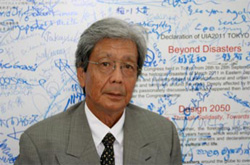Home > Highlighting JAPAN > Highlighting Japan DECEMBER 2011 > Architecture after the Quake
Highlighting JAPAN
COVER STORY: Pillars of Strength
Architecture after the Quake
The 24th World Congress of Architecture took place under the auspices of the Union Internationale des Architectes (UIA) in Tokyo from September 25 to October 1, 2011 with over 5,000 participants from Japan and around the world. The Japan Journal's Osamu Sawaji interviewed Yoshiaki Ogura, president of the UIA 2011 Tokyo Japan Organizing Board.

Yoshiaki Ogura, president of the UIA 2011 Tokyo Japan Organizing Board. Behind him, a panel signed by participants in UIA 2011 Tokyo.
Credit: THE JAPAN JOURNAL
What was discussed at UIA 2011 Tokyo, taking place as it did just half a year after the Great East Japan Earthquake?
Yoshiaki Ogura: Before the earthquake, the main theme of the event had been determined as "DESIGN 2050." This embodies our commitment to drawing up a picture of what the architecture and the city should be like in 2050 and to designing a sustainable architectural environment and quality of life. In the wake of the March earthquake, we added a subtitle of "Beyond Disasters, Through Solidarity, Towards Sustainability" to the main theme. The conference had many different discussions on the roles that architects have to play in today's society, given the relatively frequent occurrence of disasters. Among others, the keynote speech of Jigmy Yoezer Thinley, prime minister of the Kingdom of Bhutan, called on architects to think about what they could do not for economic efficiency but for the pursuit of happiness. That left a strong impression on the audience.
In the past, the UIA focused more on architectural clients. Held after the Great East Japan Earthquake, the conference in Tokyo was different in the sense that it directed its attention to people living in tough conditions. When I saw Vassilis Sgoutas, a former president of the UIA, during the conference period, he told me that the Tokyo conference was a departure from the past trend of UIA conferences.
What activities for reconstruction have architects engaged in after the Great East Japan Earthquake?
At UIA 2011 Tokyo, Shigeru Ban [see pp. 16–17] won the Auguste Perret Prize, one of the UIA special prizes. In the wake of the Great East Japan Earthquake, he designed partitions made of paper tubes to protect privacy in the evacuation centers and engaged in construction of temporary houses. Before the quake, he had been working hard to provide assistance to disaster victims and to refugees outside Japan. Reflected in these activities, his stance is highly regarded around the world.
Another architect, Toyo Ito, designed a meeting facility called Minna no Ie, meaning "House for Everyone," in a cluster of temporary houses in the city of Sendai in Miyagi Prefecture. In the past, temporary housing areas had nothing but shelters mainly made of steel plates for accommodating disaster victims. This aroused concern about their isolation. The meeting house adds a touch of the warmth of wood to the cluster and gives relief to the people there. Construction of this House for Everyone has breathed new life into the cluster of temporary houses.
What role should architects play in disaster control?
One example is to achieve a coexistence between landscape protection and disaster control. Construction of a huge seawall along the coastline for the purpose of protecting it from tsunamis has an adverse impact on the landscape. I think another duty of architects is to design something using the massive piles of rubble that resulted from the disaster in a way that does not ruin the landscape. Disaster control forests along the coast of the Tohoku region that were planted in the Edo period (1603–1867) and the Shingen-zutsumi levee in Yamanashi Prefecture constructed over 400 years ago for the purpose of preventing river flooding are now part of the landscape in their respective locales.
In 2004, Japan put into force the Landscape Act, which stipulates that the landscape is a shared national asset. To take advantage of this law and to build a safe society, the skills of architects are required.
How can Japan contribute to global disaster control through architecture?
In Japan, the Building Standards Act came into effect in 1950, establishing building standards. It was amended after the 1968 Tokachi-oki Earthquake and again after the 1978 Miyagi-ken-Oki Earthquake, because in both cases powerful tremors caused serious damage to buildings. The two revisions considerably improved the quake resistance of buildings. I think that Japan can contribute to the legislative process of developing quake resistance.
In addition, Japan's quake-proof technologies are the most advanced in the world. We not only have cutting-edge technologies but also technologies for bolstering quake resistance in a way that suits the buildings of different countries. For instance, in developing countries, an earthquake may destroy sun-dried brick houses and claim numerous human lives. A method of applying resin bands that are readily available locally onto the wall surface of sun-dried brick houses is being studied for the purpose of earthquake-proof reinforcement. Japan has also been providing Iran, Peru and other quake-prone countries with technical assistance to develop quake resistance tailored to local conditions though the Japan International Cooperation Agency.
With its experience of various disasters, Japan has been advancing its knowledge and technologies in the seismic resistance of buildings. We have an obligation to use our skills to contribute to the rest of world.
© 2009 Cabinet Office, Government of Japan






